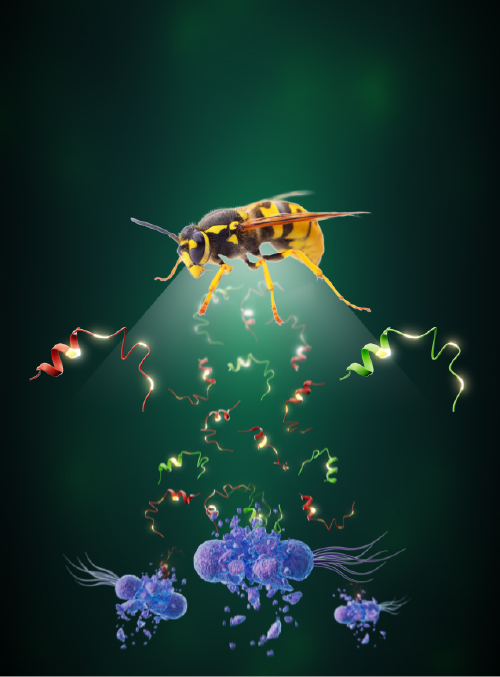 Introduction:
Introduction:
In a study published today in Cell Reports Physical Science, our team has made a significant breakthrough in the battle against bacterial infections. By harnessing the antimicrobial properties hidden within the venom of the solitary eumenine wasp Eumenes micado, we have successfully converted venom peptides into potent antimicrobial agents. This approach offers a new avenue for developing antibiotics, tapping into nature’s venoms as an underexplored source of potential treatments.
Exploring the Untapped Potential of Venom:
Traditional approaches to finding new antibiotics have predominantly focused on synthetic compounds and soil bacteria. However, this study leverages a different path by unlocking the antimicrobial potential present in venoms. By transforming two natural antimicrobial peptides (AMPs) derived from Eumenes micado’s venom into non-toxic α-helical AMPs, we have created powerful weapons against Gram-negative bacteria. These engineered peptides have demonstrated effectiveness in both laboratory experiments and a preclinical mouse model.
Unraveling the Secrets of Venom Peptides:
The key to this advance lies in identifying the specific sequence determinants responsible for the antimicrobial activity of the natural peptides. Through an extensive so-called alanine scan screen and strategic single lysine substitutions, the research team synthesized 34 derivatives. These modifications increased the net positive charge of the peptides, a crucial element for enhancing their antimicrobial activity.
Remarkable Efficacy and Resistance Prevention:
The lead synthetic peptides exhibit promising capabilities. Unlike traditional antibiotics, they are less prone to inducing bacterial resistance, offering a promising solution to combat the growing challenge of antibiotic resistance. Additionally, the modified peptides rapidly permeabilize both the outer and cytoplasmic membranes of dangerous Gram-negative pathogens, such as Pseudomonas aeruginosa. In a preclinical mouse model, the lead peptides demonstrated exceptional anti-infective efficacy, reducing bacterial loads by up to five orders of magnitude.
Tapping into Nature’s Hidden Treasures:
This research underscores the vast potential of nature’s venoms as a rich source of antibiotics. By exploring venoms, scientists gain access to a diverse range of bioactive compounds with unique mechanisms of action against bacterial pathogens. The study emphasizes the value of investigating unconventional sources and highlights the urgency of developing innovative strategies to combat antibiotic resistance.
Dr. Lucía Ageitos, one of the lead authors of the study, expressed excitement about the outcomes, stating, “This study establishes a pivotal foundation for future discoveries that aim to effectively combat pathogenic bacteria while mitigating the emergence of antimicrobial resistance—a pressing and critical public health threat.”
Conclusion:
By unlocking the antimicrobial potential within venoms, this research opens new doors in the search for effective antibiotics. By tapping into nature’s arsenal, scientists can harness the power of venom peptides to combat bacterial infections and tackle the growing threat of antibiotic resistance. This study underscores the importance of exploring unconventional sources and paves the way for innovative strategies in the fight against infectious diseases.
The research findings have been published in Cell Reports Physical Science and are now available online: https://www.cell.com/cell-reports-physical-science/fulltext/S2666-3864(23)00238-2.
For more information, please contact:
Machine Biology Group
University of Pennsylvania
Email: cfuente@upenn.edu
Authors:
Machine Biology Group
Published:
July 19, 2023
About Machine Biology Group:
The mission statement of the Machine Biology Group at the University of Pennsylvania is to use the power of machines to accelerate discoveries in biology and medicine.
